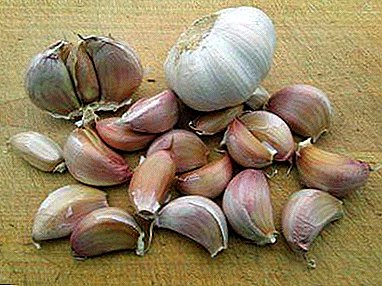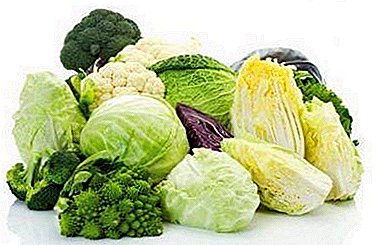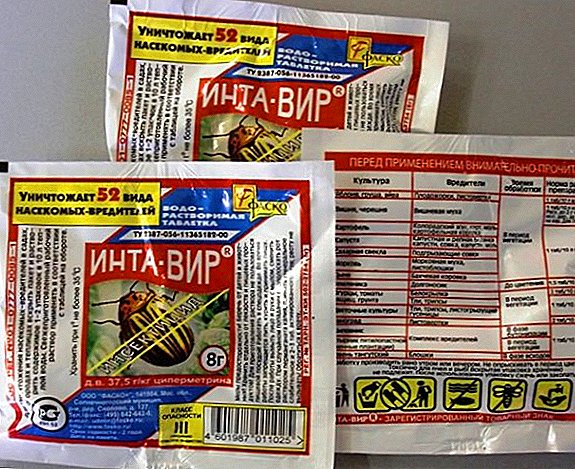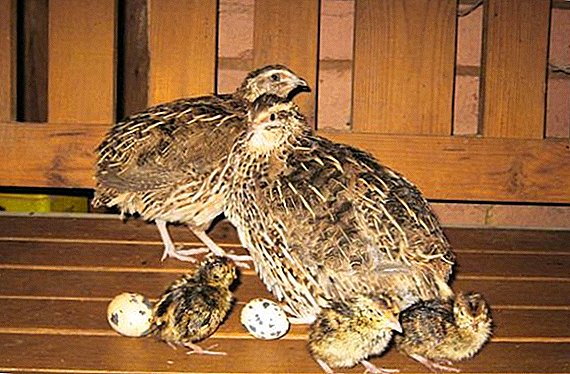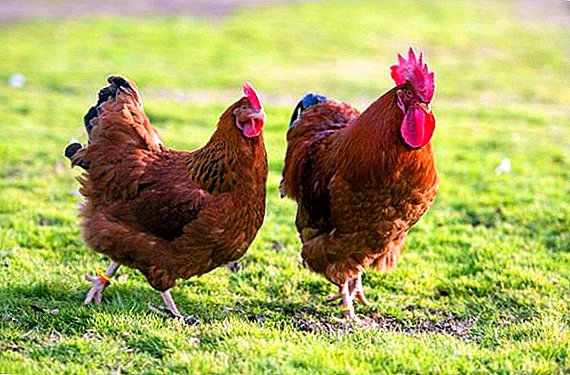 Recently, interest in breeding poultry has grown significantly. This is due, first of all, to high profitability and low costs for poultry farming. In addition, breeding chickens in their own courtyard ensures fresh and high-quality eggs and poultry meat. Let's get acquainted with the popular breed of chicken meat and egg direction - New Hampshire.
Recently, interest in breeding poultry has grown significantly. This is due, first of all, to high profitability and low costs for poultry farming. In addition, breeding chickens in their own courtyard ensures fresh and high-quality eggs and poultry meat. Let's get acquainted with the popular breed of chicken meat and egg direction - New Hampshire.
A bit of history
Originally, the New Hampshire (New Hampshire) breed was obtained in the United States based on the Red Rhode Island breed. In 1910, scientists engaged in the selection of poultry at an experimental station in New Hampshire, began to solve the problem of breeding unpretentious, fast-growing, meaty chickens that carry large eggs. In this case, their color requirements are not presented.
By the beginning of the 1930s, thanks to its excellent characteristics, the new breed gained popularity on many poultry farms in the state of the same name, as well as in Maryland, Virginia and Delaware. In 1935, its standards appeared in the specialized North American edition of The American Standard of Perfection, which made the breed widely known.  In the former USSR, New Hampshire chickens appeared in the 1940s and almost immediately received deserved recognition. Pretty soon they began to meet often in poultry farms and in individual farmsteads, and over time the breed did not lose its popularity at all.
In the former USSR, New Hampshire chickens appeared in the 1940s and almost immediately received deserved recognition. Pretty soon they began to meet often in poultry farms and in individual farmsteads, and over time the breed did not lose its popularity at all.
New Hampshire chickens were used in breeding Bielefelder breeds, Black Pantsirevskys, Kirghiz gray, Haysex crosses, ROSS-708.
Characteristics and features
As planned by scientists, New Hampshire chickens are hardy, unpretentious, productive and not bringing their masters much trouble.
Exterior
- Body. Powerful, wide, rounded.
- Head. Medium, oblong, proportional to the body.
- Neck. Medium, with lush plumage.
- Beak. Medium, strong, red-brown.
- Eyes. Red or orange-red, large, clear.
- Crest. Medium, red, leaf-like, not adjacent to the back of the head, having 4-5 uniform teeth. The lobes are almond-shaped, smooth, red. Earrings - smooth, medium, identical.
- Back. Wide, medium length, with a gradual rounded rise to the tail.
- Legs. Hocks are straight, spaced, yellow, medium length, with dark scales. The legs are muscular, prominent, of medium length.
- Tail. The rooster is medium in size with braids of medium length, sitting at a 45 degree angle to the back line. The chicken has a rather wide angle of 35 degrees.

Color
The breed has a brilliant plumage of strong and wide feathers, salmon down. The head and neck of the rooster are distinguished by a brown-red-golden color. The mane is slightly lighter, with a vertical pattern in the form of black strokes, the back and wings are dark, red-brown, with a tint. The loins are also red-brown, and the belly and chest are of a copper shade. On the tail there are several shades - black, black-green, dark chestnut and brown.  The chicken has almost identical color, but is lighter and more uniform. One-day chickens differ from the parent breed Red Rhode Island in a lighter shade of fluff.
The chicken has almost identical color, but is lighter and more uniform. One-day chickens differ from the parent breed Red Rhode Island in a lighter shade of fluff.
Important! It is quite simple to find out the floor of the chicken that was just born - the males have white down on their wings, and the females have brown with light stripes.
Character
Birds of this breed are characterized calm temper, which is especially valuable for industrial breeding conditions in cages. They are patient, give to take themselves in their arms, get along well with other birds and even succumb to a little training.  Representatives of the breed are reluctant, non-contentious, but rather friendly. In addition, they are distinguished by great curiosity and gullibility, which should be considered when planning the space for a bird.
Representatives of the breed are reluctant, non-contentious, but rather friendly. In addition, they are distinguished by great curiosity and gullibility, which should be considered when planning the space for a bird.
New Hampshire roosters are real gentlemen who carefully monitor the surrounding area and protect their ladies from potential danger.
Did you know? Chickens do not lay eggs in the dark, they are always waiting for the day or turning on the lights. And in order to determine the degree of freshness of eggs, it is necessary to place them in a container with water, while the fresh ones sink to the bottom, and the stale ones will float near the surface.
Hatching instinct
Unfortunately, during breeding it was not possible to fully preserve the maternal instinct of the breed, therefore, in some individuals, the incubation instinct is weakened. For breeding chickens you need to try different layers, for sure among them there will be one that will become an excellent mother for chicks. 
Productive characteristics
It is not for nothing that the New Hampshire breed has gained great popularity because it has excellent characteristics.
Weight gain and meat taste
Since the breed was bred as meat and egg, the breeders set themselves the task of not only high egg production, but also the excellent taste of the bird. Therefore, today, in many farms, the breed is bred precisely for the purpose of obtaining tasty and high-quality chicken meat. In this case, the weight of an adult chicken is 3-3.5 kg, and a rooster - 3.5-4.5 kg.
Familiarize yourself with the best breeds of chicken meat and egg: Amrox, Maran, Bress Gal, Plymouth.
Puberty and annual egg production
Chickens of this breed grow very quickly and over a period of six months reach puberty. At this age, they begin to carry eggs, but continue to grow even before the year.  The average number of eggs from one chicken is 200-220 pieces per year with a mass of one egg - 65-70 grams. Their number and size are directly dependent on the conditions in which the hen is, its feeding and age. The eggshell is usually painted in shades of brown of varying intensity.
The average number of eggs from one chicken is 200-220 pieces per year with a mass of one egg - 65-70 grams. Their number and size are directly dependent on the conditions in which the hen is, its feeding and age. The eggshell is usually painted in shades of brown of varying intensity.
Conditions of detention
Despite the unpretentiousness of the breed, it is necessary to properly arrange her hen house and provide the necessary comfort.
Coop Requirements
The size of the chicken coop is determined based on the total number of birds, the optimal number is 2-3 individuals per square meter. Most often, a rectangular structure is made with convenient access to all its corners, so that it can be easily cleaned with a long scraper or other tool. For the entry of light, one window should be provided, which can be shuttered shutters and, thus, adjust the length of the daylight.
We advise you to read about the intricacies of choosing a chicken coop when buying, as well as self-production.
Although this breed tolerates temperature fluctuations well, it is desirable that the temperature in the house does not fall below zero. In addition to insulation, it should also be ensured that there are no drafts in the hen house. If possible, keep it clean and dry. To do this, you need to spread straw on the floor and change it daily. Also, to reduce the humidity in the room and for the convenience of cleaning on the floor, you can pour sand.  Hens like normal air humidity, so a hole should be provided for the air flow during the planning phase of the chicken coop. For this purpose it is good to use a piece of plastic pipe inserted into the wall.
Hens like normal air humidity, so a hole should be provided for the air flow during the planning phase of the chicken coop. For this purpose it is good to use a piece of plastic pipe inserted into the wall.
Although New Hampshire chickens often reluctantly use established nests, and seek secluded places, nests should still be organized. It is best to place them on the floor and provide for egg collectors.
Learn more about the arrangement of the chicken coop: how to make ventilation, nests, perches.
Periodically inside should be put tank with a mixture of sand and ash. Birds love to take baths in it, at the same time getting rid of parasites on the skin and feathers.
Walking yard
If possible, it is worthwhile to organize hens walking where they could walk freely and tweak weed. This has a very positive effect on the health and development of birds.  For such walks no need for large fences, because New Hampshire chickens cannot take off, and when danger arises they usually flee. Therefore, you can simply fence off a small area adjacent to the chicken coop, a low net-rabbit.
For such walks no need for large fences, because New Hampshire chickens cannot take off, and when danger arises they usually flee. Therefore, you can simply fence off a small area adjacent to the chicken coop, a low net-rabbit.
Did you know? Sometimes there are chicken eggs with two yolks, but this does not mean that twin chickens will hatch from such eggs. Two chicks simply do not have enough space in one shell, and they will not be able to develop there.
Feeders and drinkers
For birds, be sure to provide feeders and drinkers. At the same time you need to constantly monitor the quantity and quality of food and water. If there was a lot of garbage in the drinking bowl, and the water began to bloom or became rotten, then it cannot be drunk, as this can cause various diseases. Chicks up to two months are recommended to give only boiled or purified water.
In addition, once a week you need to do complete disinfection of feeders.
How to endure cold and heat
The breed has established itself as resilient, adapted to difficult weather conditions and resistant to temperature changes. However, at too low temperatures, the scallops of birds can freeze, so it is worthwhile to provide additional heating for the room.  By the way, in the winter season, New Hampshire hens also sweep pretty well.
By the way, in the winter season, New Hampshire hens also sweep pretty well.
Moult
Shedding is a natural and necessary for health process in which the hens dispose of old feathers and grow new ones. It takes place at the end of autumn and in winter and is caused by a short duration of daylight hours.
It should be noted that during the molt, egg-laying may cease even in the most productive hen. However, do not panic - good nutrition and favorable conditions will help to quickly go through this period and return to the old productivity.
Read also about feeding laying hens at home.
What to feed an adult flock
Birds of this breed are completely undemanding to food, but you should observe a balanced and full-fledged diet, because their weight gain and egg production directly depend on this. Food must necessarily contain carbohydrates, proteins, fats and vitamin-mineral complex.
Adults should be given cereals, corn, greens, vegetables, roots, yeast, clover and fish meal, as well as ground egg shell to compensate for the lack of calcium. Particular attention is paid to the diet of the hens, which should be rich in easily digestible protein and vitamins. Such quality, for example, has a ready-made feed for poultry.  Experienced poultry farmers for good digestion of chickens are advised to add sand to food. We must not forget about enough fresh water in the drinkers.
Experienced poultry farmers for good digestion of chickens are advised to add sand to food. We must not forget about enough fresh water in the drinkers.
Breeding chicks
In order to breed chicks, it is necessary to properly incubate the eggs, know how to care for the chicks, and what to feed them.
Important! The New Hampshire breed has excellent survival rates, which are: for chickens up to 86%, and for adults - about 92%.
Egg Incubation
Even in the absence of a hen to bring the chicks at home is not difficult. To do this, take high-quality eggs from developed layers and place them in a special incubator. After that, maintain the desired temperature in it, provide ventilation and humidity and turn them over in time. The best option would be to purchase an automatic incubator that will successfully cope with all these tasks. With a good starting material and proper incubation process, hatchability of chicks can reach 100%.  Incubation parameters:
Incubation parameters:
- average time - 21 days;
- average temperature - +37.8 degrees Celsius;
- humidity - 50-55% (7 days), 45% (7 days), 50% (4 days), 65% (3 days);
- coup - every 4-6 hours.
Learn more about growing chickens in an incubator: characterizing the best incubators, do-it-yourself incubator; disinfection, laying, eggs copying.
Care for the young
For healthy development, chickens should be pre-cleaned, washed and sanitized premises, feeders and drinkers. The room where the chickens will live should be clean, dry and warm. We must not allow large crowding so that the young do not suffer from malnutrition and lack of space. In addition, microclimate parameters deteriorate in cramped conditions, dampness appears, which leads to many diseases and even death of birds.
To begin with, the temperature in the room should be + 28 ... +30 degrees Celsius, by two weeks of age the chicks can be lowered to + 20 ... +22. At the same time, the air humidity should be 65-75%.  The main indicator of comfortable conditions is the behavior of chickens - they must be vigorous, active and well consume food.
The main indicator of comfortable conditions is the behavior of chickens - they must be vigorous, active and well consume food.
If you are breeding chicks with an incubation method, you can build a brooder for further breeding.
Chicken diet
Only hatched chicks feed on chopped boiled eggs. Gradually, vegetables, fresh greens, wheat bran and root vegetables such as carrots, potatoes, and beets are added to the diet. In addition, a combined feed for chickens can be included as the main nutrient. Bean crops and cereals - oats, barley, and crushed wheat are gradually introduced. At the age of two months, the chick is ready to eat corn.
Also, chickens are useful ground egg shell to fill the desired level of calcium in the body.
Herd replacement
To maintain a constant high egg production, it is necessary to carry out a scheduled replacement of birds. For New Hampshire layers, this period is two years from the first clutch. From the third year, their productivity begins to decline to 120-140 eggs, until it stops almost completely.  In addition, in order to maintain breed standards, every 4-5 years you need to take a new rooster. And it is desirable to buy it in other farms.
In addition, in order to maintain breed standards, every 4-5 years you need to take a new rooster. And it is desirable to buy it in other farms.
Did you know? In order to carry eggs, the chicken does not need a rooster at all. Just such unfertilized eggs are suitable only for culinary purposes and of them can not appear chickens.
The breed's tendency to disease
New Hampshire people most often suffer from colds. To avoid this, you should insulate their home in the frosty time. To strengthen the immune system should be introduced into the diet of fish oil and vitamin supplements.
Advantages and disadvantages
Advantages of the New Hampshire breed:
- high egg production;
- rapid weight gain, fleshyness;
- unpretentious care;
- pickiness to feed;
- good fertility and survival;
- simplicity in the content.
Cons breed New Hampshire:
- sensitivity to frost;
- underdeveloped instinct nasizhivaniya individual chickens.
Video: New Hampshire Hens
Poultry breeders reviews of the New Hampshire breed


So, no wonder these unassuming and elegant birds have gained great popularity in many countries. If you want, with minimal effort, to provide yourself with quality meat and a large number of eggs, then one of the best options is breeding New Hampshire chickens.


